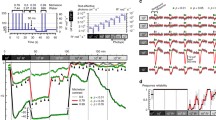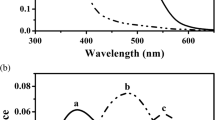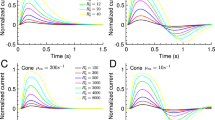Abstract
Amphibian “green” rods express a blue-sensitive cone visual pigment, and should look yellow. However, when observing them axially under microscope one sees them as green. We used single-cell microspectrophotometry (MSP) to reveal the basis of the perceived color of these photoreceptors. Conventional side-on MSP recording of the proximal cell segments reveals no selective long-wave absorbing pigment explaining the green color. End-on MSP recording shows, in addition to the green rod visual pigment, an extra 2- to 4-fold attenuation being almost flat throughout the visible spectrum. This attenuation is absent in red (rhodopsin) rods, and vanishes in green rods when the retina is bathed in high-refractive media, and at wide illumination aperture. The same treatments change the color from green to yellow. It seems that the non-visual pigment attenuation is a result of slender green rod myoids operating as non-selective light guides. We hypothesize that narrow myoids, combined with photomechanical movements of melanin granules, allow a wide range of sensitivity regulation supporting the operation of green rods as blue receptors at mesopic-to low-photopic illumination levels. End-on transmittance spectrum of green rods looks similar to the reflectance spectrum of khaki military uniforms. So their greenness is the combined result of optics and human color vision.









Similar content being viewed by others
Abbreviations
- BSA:
-
Bovine serum albumin
- IS:
-
Inner segment
- LED:
-
Light-emitting diode
- MSP:
-
Microspectrophotometer
- NA:
-
Numerical aperture
- OD:
-
Optical density
- OLM:
-
Outer limiting membrane
- OS:
-
Outer segment
- ROS:
-
Rod outer segment
- RPE:
-
Retinal pigment epithelium
- VP:
-
Visual pigment
References
Arey LB (1916) Changes in the rod-visual cells of the frog due to the action of light. J Comp Neurol 26:429–441
Bäck I, Donner KO, Reuter T (1965) The screening effect of the pigment epithelium on the retinal rods in the frog. Vis Res 5:101–111
Bäckström A-C, Reuter T (1974) Opponent colour interaction between two kinds of rod signals in the frog’s retina. Phys Nor 7:187–189
Baumann Ch (1977) Boll’s phenomenon. Vis Res 17:1325–1327
Boll F (1877) Zur Anatomie und Physiologie der Retina. Arch Anat Physiol (Physiol Abt) 1877:4–36 (Translated into English and reprinted: Boll F (1977) On the anatomy and physiology of the retina. Vis Res 17:1249–1265)
Bowmaker JK (1977) Long-lived photoproducts of the green-rod pigment of the frog, Rana temporaria. Vis Res 17:17–23
Dartnall HJA (1957) The visual pigments. Methuen, London, pp 1–216
Dartnall HJA (1967) The visual pigment of the green rods. Vis Res 7:1–16
Denton EJ, Wyllie JH (1955) Study of the photosensitive pigments in the pink and green rods of the frog. J Physiol 127:81–89
Donner KO, Reuter T (1962) The spectral sensitivity and photopigment of the green rods in the frog’s retina. Vis Res 2:357–372
du Pont JS, de Groot PJ (1976) A schematic dioptric apparatus for the frog´s eye (Rana esculenta). Vis Res 16:803–810
Govardovskii VI, Fyhrquist N, Reuter T, Kuzmin DG, Donner K (2000) In search of the visual pigment template. Vis Neurosci 17:509–528
Hárosi FI (1975) Absorption spectra and linear dichroism of some amphibian photoreceptors. J Gen Physiol 66:357–382
Hárosi FI (1982) Recent results from single-cell microspectrophotometry: cone pigments in frog, fish, and monkey. Color Res Appl 7:135–141
Hisatomi O, Takahashi Y, Taniguchi Y, Tsukahara Y, Tokunaga F (1999) Primary structure of a visual pigment in bullfrog green rods. FEBS Lett 447:44–48
Kicliter E, Kay CJ, Chino YM (1981) Spectral opponency of on-type ganglion cells and the blue preference of Rana pipiens. Brain Res 210:103–113
Kolesnikov AV, Golobokova EYu, Govardovskii VI (2003) The identity of metarhodopsin III. Visual Neurosci 20:249–265
Kondrashev SL, Gnyubkin VF (1978) Contribution of green rods to the visual process in anurans. In: Orlov O Yu (ed) Mechanisms of vision in animals. Nauka, Moscow, pp 76-84 (In Russian)
Koskelainen A, Hemilä S, Donner K (1994) Spectral sensitivities of short- and long-wavelength sensitive cone mechanisms in the frog retina. Acta Physiol Scand 152:115–124
Liebman PA, Entine G (1968) Visual pigments of frog and tadpole (Rana pipiens). Vis Res 8:761–775
Ma J-x, Znoiko S, Othersen KL, Ryan JC, Das J, Isayama T, Kono M, Oprian DD, Corson W, Cornwall MC, Cameron DA, Hárosi FI, Makino CL, Crouch RK (2001) A visual pigment expressed in both rod and cone photoreceptors. Neuron 32:451–461
Matthews G (1983) Physiological characteristics of single green rod photoreceptors from toad retina. J Physiol 342:347–359
Maurer EY, Govardovskii VI (2013) Regeneration of visual pigments in the isolated retina of the frog Rana temporaria. Sens Syst 27:99–107 (in Russian)
Maximov VV, Orlov OY, Reuter T (1985) Chromatic properties of the retinal afferents in the thalamus and the tectum of the frog (Rana temporaria). Vis Res 25:1037–1049
Miller WH, Snyder AW (1972) Optical function of myoids. Vis Res 12:1841–1848
Muntz WRA (1962a) Microelectrode recordings from the diencephalon of the frog (Rana pipiens) and a blue-sensitive system. J Neurophysiol 25:699–711
Muntz WRA (1962b) Effectiveness of different colors of light in releasing positive phototactic behavior of frogs, and a possible function of the retinal projection to the diencephalon. J Neurophysiol 25:712–720
Nilsson SEG (1964a) An electron microscopic classification of the retinal receptors of the leopard frog (Rana pipiens). J Ultrastruct Res 10:390–416
Nilsson SEG (1964b) Interreceptor contacts in the retina of the frog (Rana pipiens). J Ultrastruct Res 11:147–165
Orlov OY (1961) Difference in the frog optic nerve reactions depending on the colour of the stimulus. Biofizica 6:77–83 (In Russian)
Orlov OY, Kondrashev SL (1978) Colour-discrimination functions of visual projections in frog. In: Orlov OY (ed) Mechanisms of vision in animals. Nauka, Moscow, pp 135–165 (In Russian)
Reuter T (1976) Photoregeneration of rhodopsin and isorhodopsin from metarhodopsin III in the frog retina. Vis Res 16:909–917
Sidman RL (1957) The structure and concentration of solids in photoreceptor cells studied by refractometry and interference microscopy. J Biophys Biochem Cytol 3:15–30
Snyder AW (1975) Photoreceptor optics—theoretical principles. In: Snyder AW, Menzel R (eds) Photoreceptor optics. Springer, Berlin, pp 38–55
Walls GL (1942) The vertebrate eye and its adaptive radiation. Cranbrook Press, Michigan, pp 1–785
Wijngaard W, Heyker H (1975) Optical interaction between retinal receptors. In: Snyder AW, Menzel R (eds) Photoreceptor optics. Springer, BerlinHeidelberg, pp 167–174
Acknowledgments
Experimental animals were treated in accordance with the Guide for the Care and Use of Laboratory Animals (1996. National Academy of Sciences, Washington, DC) and with the rules approved by the local Institutional Animal Care and Use Committees. The Authors are thankful to Vadim Maximov, Oleg Orlov and Christa Neumeyer for many helpful discussions. The work was supported by the Grant # 13-04-00701 from The Russian Foundation for Basic Research to V.G., and by a grant from the Finnish Society of Sciences and Letters to T. R.
Conflict of interest
Authors declare no conflict of interests.
Author information
Authors and Affiliations
Corresponding author
Rights and permissions
About this article
Cite this article
Govardovskii, V.I., Reuter, T. Why do green rods of frog and toad retinas look green?. J Comp Physiol A 200, 823–835 (2014). https://doi.org/10.1007/s00359-014-0925-z
Received:
Revised:
Accepted:
Published:
Issue Date:
DOI: https://doi.org/10.1007/s00359-014-0925-z




